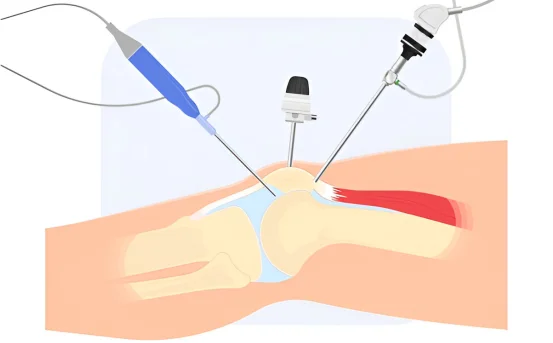The Meniscus acts as a cushion in the knee between your femur bone and your tibia bone. Each knee has two menisci – one medial (inner), and the other lateral (outer). The soft cartilage may be damaged by sports injuries, trauma or aging. This can result in a tear. Understanding of types of meniscus repair surgery.
Meniscus tears are common in athletes and older adults. Depending on severity and location, there are various meniscus repairs that can be performed to restore knee functionality, relieve pain and prevent long-term damage.
When is meniscus surgery needed?
Some minor tears can heal with physical therapy and rest. Minor tears can be healed with rest and physical therapy. Surgery may be required in the following situations:
- The knee locks or feels caught.
- Pain and swelling persist
- Unable to bend or straighten the knee fully
- Tear the red-red and red-white areas (areas that have blood supply).
- Tears caused by trauma and sports injuries
To determine if meniscus surgery will be required, it is important to have a proper MRI scanner and an orthopedic evaluation.
Meniscus Repair Surgery: Understanding the main types
The treatment of a torn lateral meniscus can be done in a variety of ways. The types of meniscus repair surgery, its size, its location, the patient’s age and level of activity will determine which surgical approach is best.
Repair of Arthroscopic Meniscus
Arthroscopic Meniscus Repair is an minimally invasive procedure that stitches the cartilage pieces back together. This is the most common form of meniscus surgery.
Procedure:
- Around the knee, small incisions can be made.
- To view the tear, an arthroscope is inserted (a small camera).
- Suture the tears using specialized tools.
- After cleaning the area, the incisions will be closed.
Pros:
- Minimum Invasive
- Faster recovery
- Scarring is reduced
- Meniscus natural preserved
Best for:
- Younger patients
- Tears on the outer edge (with blood supply).
Partial Meniscectomy
partial mesiscectomy is recommended if the tear is located in an area with no blood supply, or if there is severe cartilage damage. This procedure removes only the damaged portion of the meniscus.
Procedure:
- Similar arthroscopic approaches
- Meniscus pieces are cut away
- The remaining cartilage will be smoothed
Pros:
- Relieves pain quickly
- Full repair is not necessary for a quick recovery
Cons:
- Loss of cushioning may lead to arthritis in the future
Best for:
- Degenerative tears
- Inner zone or complex tears
- Adults aged over 60
Meniscus Root Repair
The root of the meniscus anchors the cartilage on the tibia. This root can be torn and disrupt the load-bearing functions of the meniscus. It is similar to a meniscus being removed.
Procedure:
- Arthroscopic technique
- Meniscus roots reattached using bone tunnels and sutures
- Restores normal knee mechanics
Best for:
- Posterior Root Tears
- Patients with early arthritis or joint instability
Meniscus Allograft Transplantation
A meniscus implant is a possible solution for patients with knee pain after a meniscectomy due to a loss of meniscal functionality.
Procedure:
- The damaged meniscus is replaced by donor tissue (cadaver).
- The graft must be sized and matched.
- Open or arthroscopic surgery
Best for:
- Younger patients under 50
- Meniscus surgery and persistent pain
- No advanced arthritis
Open Meniscus Repair
open Meniscus Repair is rare, but it may be done in cases of complex knee conditions where arthroscopic surgery is not possible or in conjunction with other knee procedures.
Best for:
- Combination ligament surgery
- Meniscal tears with unusual patterns
Meniscus Repair Surgery Recovery
The recovery time depends on what type of surgery was performed.
Rehabilitation includes:
- Physical therapy can help restore strength and range of motion
- Avoid deep squats at first and avoid twisting motions
- Gradual return to sport (usually after 4-6 weeks)
Risks and Complications
Although meniscus surgery is generally considered safe, there are some potential complications.
- Infection
- Stiffness
- Blood Clots
- Meniscus re-tear
- Arthritis with time (especially following partial meniscectomy).
Following your surgeon’s instructions and ensuring you have the right postoperative care can help minimize risk.
Conclusion
Meniscus tears don’t mean the end of an active lifestyle. Modern meniscus repairs allow patients to regain their knee function, and resume sports or everyday activities. The best treatment depends on the location, severity, and type of tear as well as the individual’s health goals.
Consult an experienced orthopedist if you are experiencing knee pain, or if you have been diagnosed as having a torn meniscus. They can help you determine the best surgical option.























